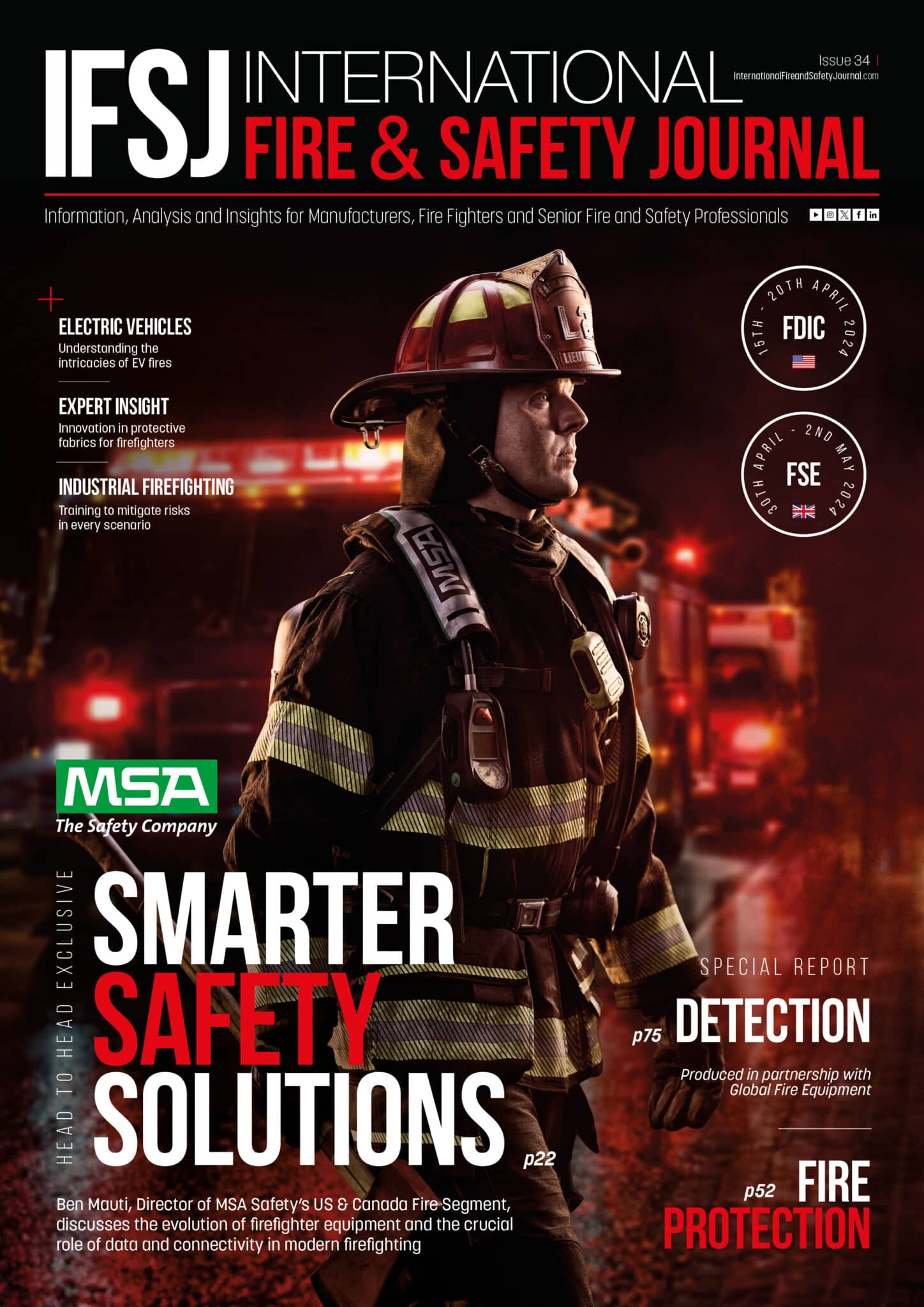Exclusive: TLX Technologies talk adding value to suppression systems
- June 1, 2022
- 11:00 am


Iain Hoey
Share this content
With an approach towards product development to add value to suppression systems, TLX Technologies highlights some key innovations from the firm
As the fire protection industry gathers this summer for Interschutz 2022 in Germany, it is interesting to look back on how much has changed since the last event was held seven years ago.
While there has been development and growth across all aspects of the industry, TLX Fire & Security, a division of TLX Technologies, has been focused on the changes in standards as well as the adoption of better security features on fire suppression systems worldwide.
In January 2016, shortly after the last Interschutz show, NFPA 2001: Sec. 4.3.4.1 (a standard for supervision on actuation devices for fixed gaseous fire suppression systems) went to effect. The goal behind the introduction of this standard was to provide a means for ensuring that the actuating device would be correctly installed on the system, at both initial installation and also after periodic maintenance, by providing a visible and audible signal at the fire panel when the actuator was either disconnected or not installed properly.
TLX showcased its first product that met this new standard for supervision at Interschutz 2015. Since that time, system manufacturers across the globe have been adopting this standard for their actuating devices to ensure proper installation, especially for those systems that would be sold into areas where the NFPA guidelines are observed. Additionally, other regions have seen the benefit of updating their own standards in like manner. For example, later this year the European standard (EN 15004) will be changing to require supervision of actuating devices to better align with the NFPA standard that has been in effect for the last six years. While the initial NFPA standard was designated specifically for fixed gaseous fire suppression systems, NFPA recently expanded that standard to water systems with the update to standard NFPA 13: Sec. 8.3.1.2.1 that went into effect in January of last year.
Although TLX has been designing and producing actuation devices for fixed gaseous fire suppression systems for over 20 years, they have seen marked growth since developing their first product that met NFPA standards for supervision. They expect that growth to continue in the coming years as regulatory standards further align globally across the fire suppression industry.
Since their first product introduction, TLX has added several additional actuators to their portfolio to meet the requirements of suppression systems with higher operating pressures. They also added manual actuation and reset options for their actuators along with a pneumatic actuator that pairs with their electric actuators to provide customers with a full system solution. All their electric actuators are UL 864 Recognized and meet the NFPA requirements for supervision.
New Products Showcased
TLX approaches product development with the goal of giving system manufacturers access to solutions that will add value to their suppression systems. This year TLX Fire & Security will be showcasing their new patented Explosion Proof Actuator with Supervision and their Liquid Level Sensor at both the NFPA and Interschutz shows in June.
Fire suppression systems for hazardous environments typically rely on an actuation device and additional tubing between the actuation device and the storage tank to route discharge pressure through the system. This creates the potential for a number of leak points. Additionally, such systems require an enclosure so that if flammable gas were to make its way into the actuation device and ignite, any fire would be contained within the enclosure and would not cause combustion of any flammable substances in the atmosphere.
TLX had received numerous inquiries about possible solutions that would satisfy safety requirements for hazardous locations. Their team decided to develop a top-mounted linear actuator that acted as its own enclosure. The result was the Explosion Proof Actuator with Supervision, which is UL HazLoc, ATEX, and IECEx certified for use in hazardous locations and meets NFPA requirements for supervision.
The actuator’s top-mounted design means that it does not act as a pressure vessel on the discharge valve. This eliminates the extra connections that other solutions rely on to connect the actuator to the storage tank and route discharge pressure through the system. As a result, the only potential leak point at the tank is at the top of the discharge valve. Additionally, special design features and material grade selection allow the actuator to act as its own enclosure. All potential flame paths are specifically designed to prevent flame egress in the event a spark were to ignite any gas found in the actuator.
Because every system is unique, the actuator can be customized to fit any system. The internal components can be configured during production to match any operating pressure up to 300 bar. The interface can also be fully customized: mounting thread, connection type (male or female), firing pin stick out, and firing pin geometry can all be configured according to the customer’s specifications.
The Explosion Proof Actuator with Supervision provides an all-in-one solution for hazardous locations that simplifies installation and maintenance and helps improve system reliability.
While TLX has long specialized in producing the most innovative actuation devices, they have taken their technological expertise and applied it to integrated sensing to satisfy other needs in the fire suppression industry. Most recently, they developed a liquid level measuring device that offers a better alternative to current methods of determining the level of extinguishing agent in a system’s storage tanks.
Most solutions for measuring the level of extinguishing agent require a technician to take a manual reading and calculate the weight using a conversion table. Accurately calculating the weight of the extinguishing agent is crucial for keeping the system operating, and manually calculating conversion table data creates the potential for errors.
TLX Fire & Security developed a solution that would eliminate the potential for human error that is inherent in many of the methods currently being used. The Liquid Level Sensor automatically provides a thermally compensated weight reading of the extinguishing agent in the fire suppression system’s storage tanks. The sensor is comprised of a sealed tube with a magnetic float mounted on the outside of the tube. This tube is installed in each tank prior to being filled with the extinguishing agent. There is another magnetic float inside the tube that interlocks with the float outside the tube, providing an accurate measurement of the fluid level inside the tank. At the end of the tube at the top of the tank is a sensor that sends float position and temperature data to a microcontroller that is preprogrammed with a conversion table for that specific tank and extinguishing agent configuration. The microcontroller then automatically calculates the weight of the extinguishing agent inside the storage tank.
The weight of the extinguishing agent can be displayed directly at the tank on a digital display or transmitted to the fire control panel via hardwired or wireless connection. Data can also be accessed remotely or downloaded using a USB connection. Additionally, a simple GO/NO-GO status can be displayed with a green/red LED to indicate the status of the storage tank.
While the Liquid Level Sensor is an ideal solution for many fire suppression systems, some systems require the tanks to be weighed. For such systems, TLX is currently developing the Hanging Weight Sensor and Platform Weighing Sensor. These sensors will feature continuous monitoring, high accuracy (100 g resolution), and 500 kg maximum capacity. These weighing sensors are scheduled to be available to the market in the second half of 2022.
The Future of the Industry
Data collection and the Internet of Things (IoT) has revolutionized the way businesses operate in nearly every industry. Everything from warehouses to manufacturing has used this technology to add value and improve efficiency. Warehouses have dramatically improved inventory accuracy and pick and ship times. Data can be collected and analyzed on manufacturing equipment for predictive and preventative maintenance, minimizing downtime.
However, the fire suppression industry has been slow to explore the ways that data collection and remote monitoring can improve safety and efficiency and bring value to their fire suppression systems. The changes brought to the world by the COVID-19 pandemic, often resulting in fewer people on-site and the explosion of remote work, has caused the industry to more seriously consider how IoT can be best used.
Data collection and IoT can make fire suppression systems safer and more efficient than they have ever been. Typically, fire suppression systems are only inspected biannually. If there is a fault in the system, it may not be detected until one of these inspections. But with remote monitoring, system faults can be detected almost immediately and addressed in the most efficient manner possible. This makes for a safer, more valuable system.
This technology promises to bring considerable value to all stakeholders. It is critical that the industry begins considering how data collection and IoT can be deployed. As customers begin to realize how this technology is benefitting other systems they rely on, they will look to the fire suppression industry for similar solutions for their fire suppression systems. If the industry fails to seize the opportunity to utilize this technology, another industry may step in and fill the void. The HVAC industry is already using this technology, and they may begin to include fire suppression data collection in their monitoring systems. By investing in this technology, the fire suppression industry can take an important step to ensure its growth and profitability.
This article was originally published in the May edition of IFSJ. To read your FREE digital copy, click here



